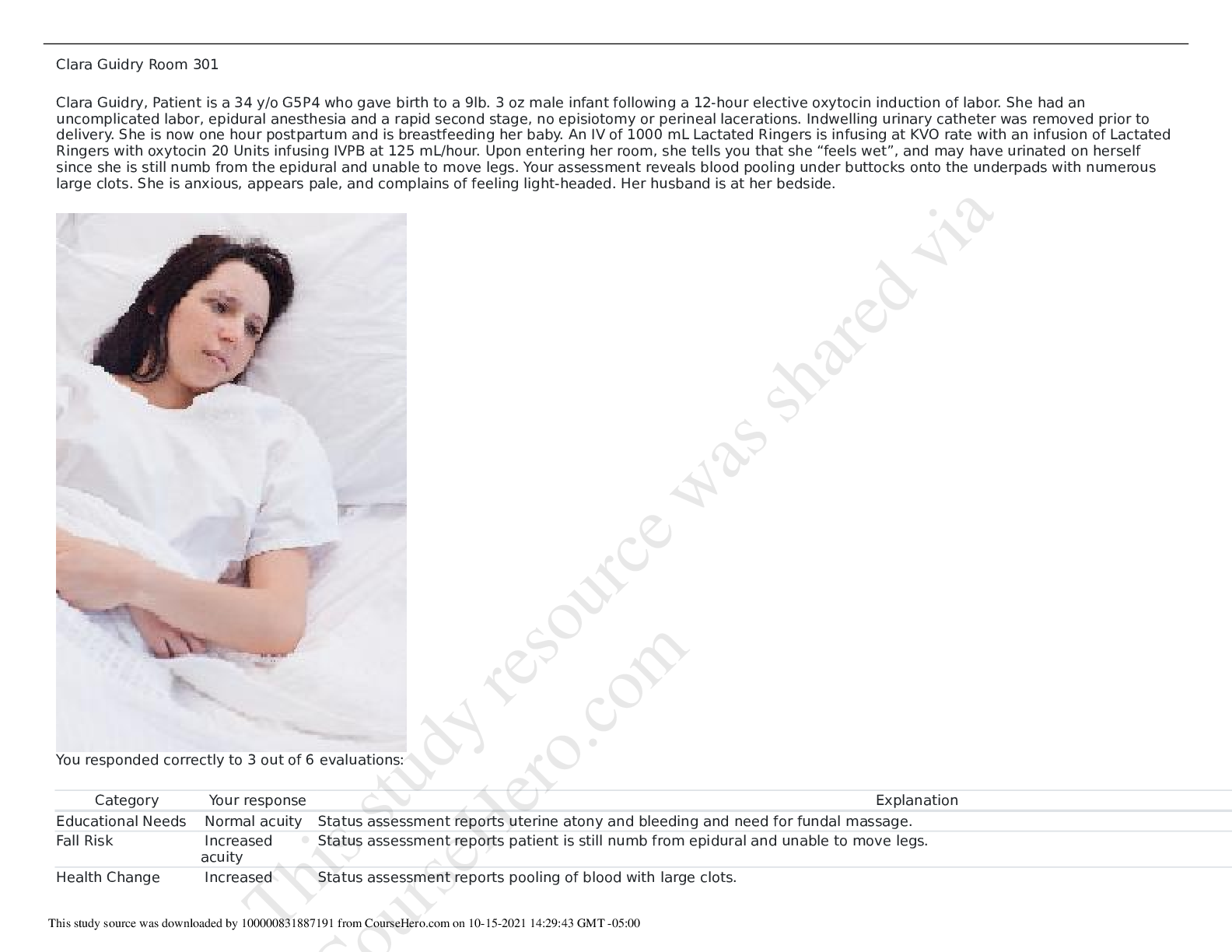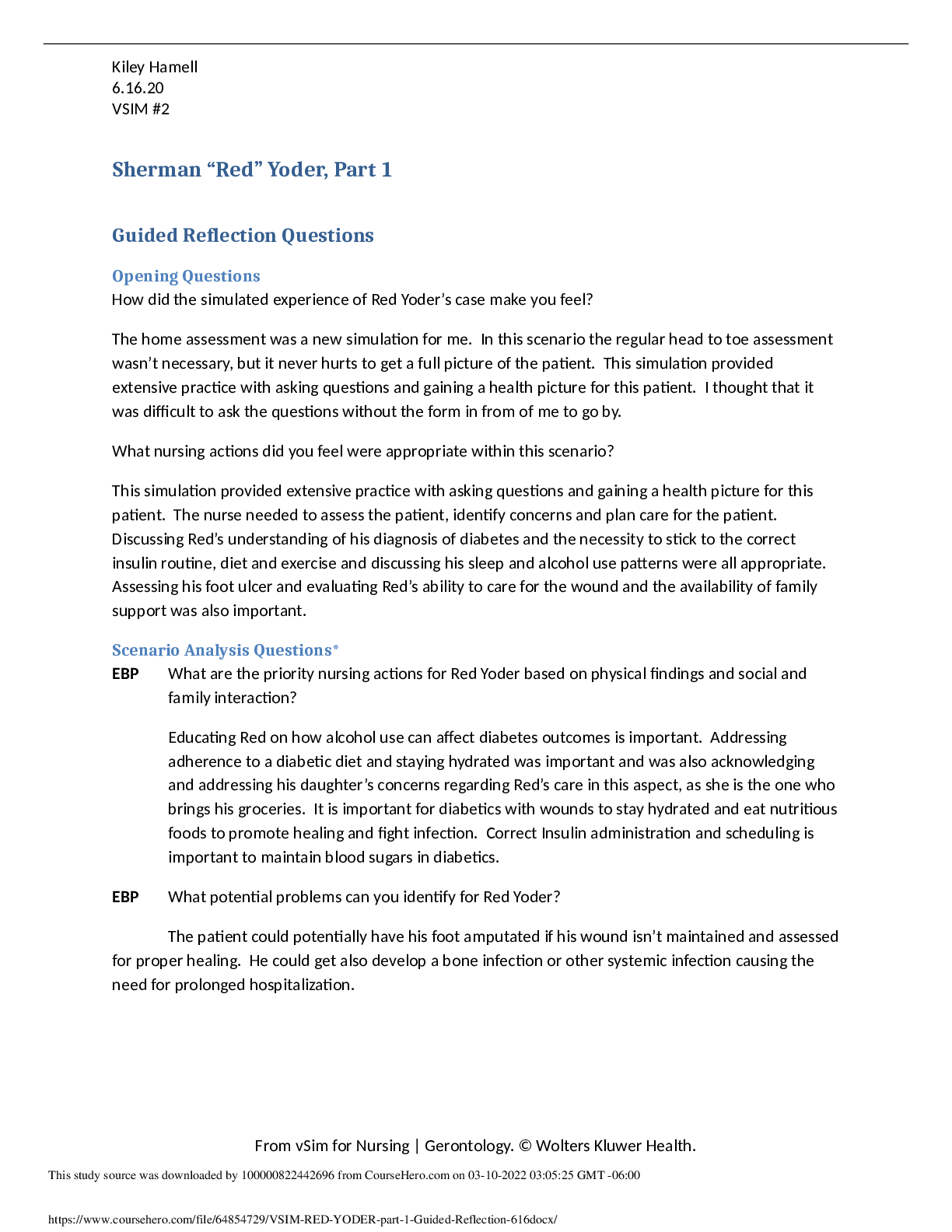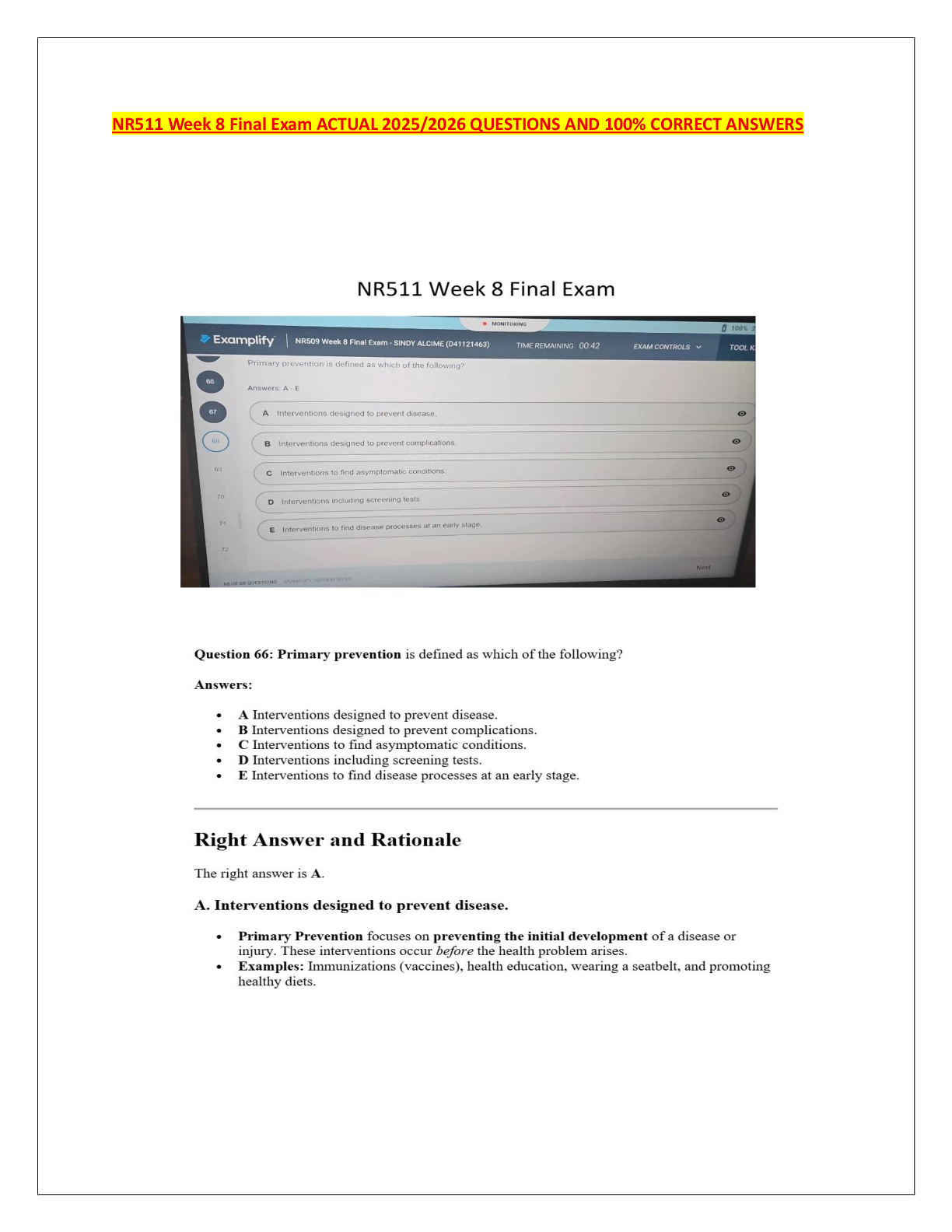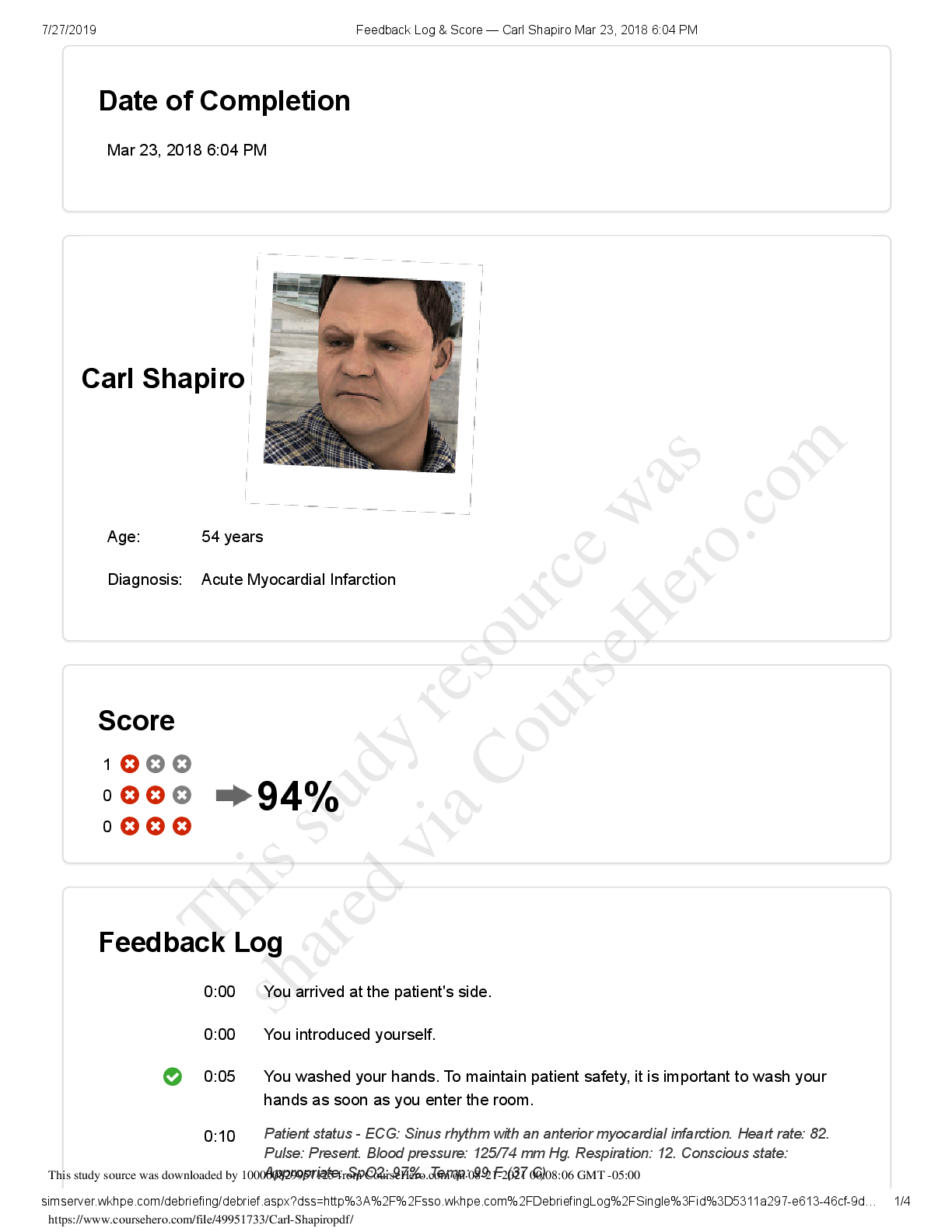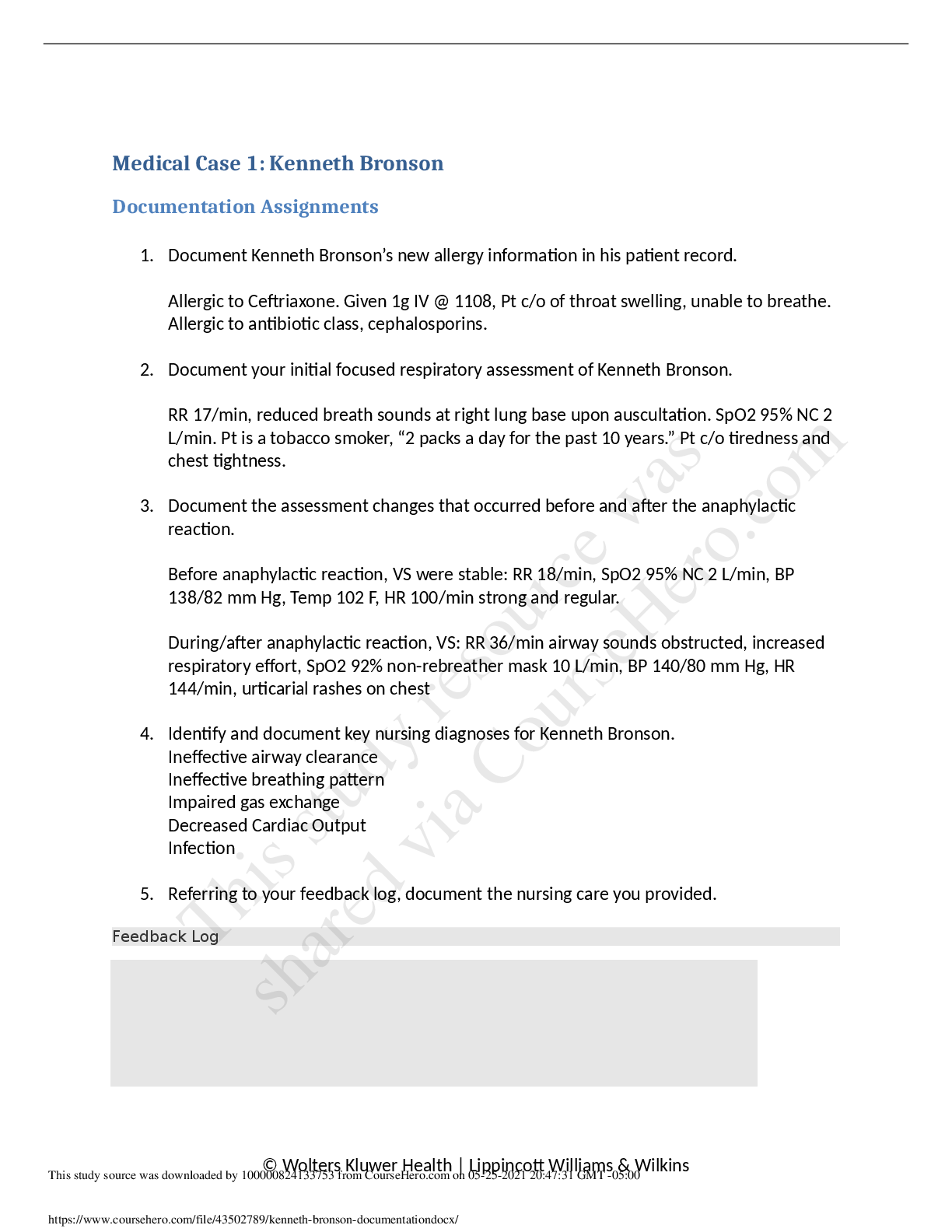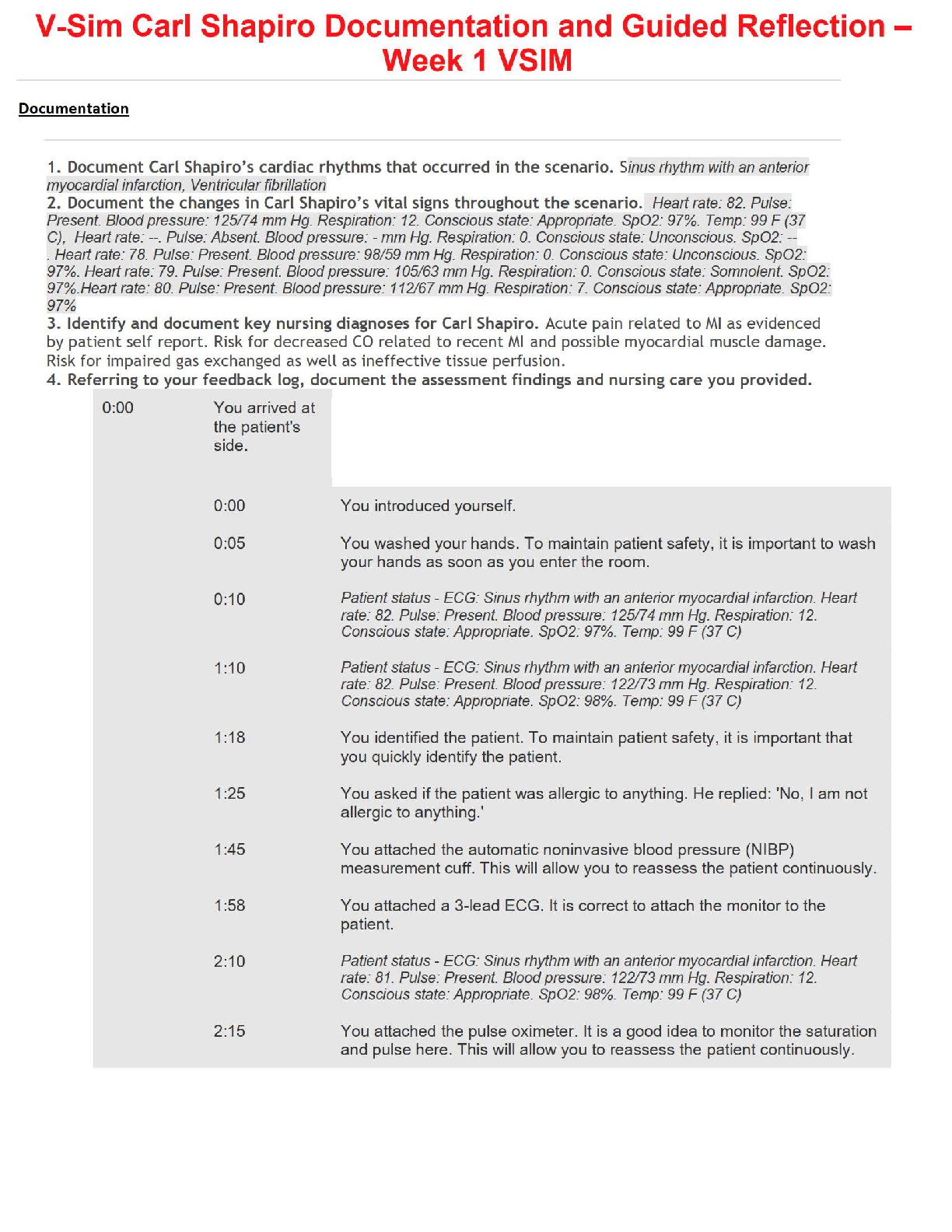*NURSING > vSim For Nursing > Community Health - Swift River Cases Scenarios; all answered and graded. (All)
Community Health - Swift River Cases Scenarios; all answered and graded.
Document Content and Description Below
Community Health - Swift River Cases Scenarios; all answered and graded. Judith Hanks Room Judith Hanks, 64-year-old woman discharged about one year ago from the hospital following discectomy to rep ... air a herniated disc. During that hospitalization, Judith’s husband of 9 years, Elton, visited her and found her behavior very different from her usual behavior. As his with her visit progressed, Judith began having tactile hallucinations and was very restless. Finally, Judith’s husband called the hospital nurse into the room and the nurse found Judith hypertensive and tachycardic and Judith was very diaphoretic. Judith and her husband both revealed that they were drinking 8- 10 alcoholic beverages per day. As part of that hospitalization Judith went through alcohol withdrawal and was diagnosed with alcohol-related cirrhosis and began care for condition. Judith also has a history of heart failure which was stabilized during the hospitalization. Current medications include: carvedilol (Coreg) 3.125 mg twice daily, spironolactone (Aldactone) 200 mg/day, Vitamin B Complex (1/day), MVI (1/day) Allergies: Shellfish, adhesive tape. As part of the management and discharge processes, both members of the couple pledged to become sober and were generally successful over the past year with ongoing support group participation at the Alcoholics Anonymous at a local church. They have both had one or two serious relapses of using alcohol when life stressors were more than they can handle. One night, Elton went to a local bar, after an argument with his wife, and drank all evening. When driving home, he was the cause of a motor vehicle accident which caused no injuries but damaged his car beyond repair. Their children decided to take both Judith and Elton’s licenses away and do errands for them every few weeks. This caused Judith and Elton to not be able to attend their Alcoholics Anonymous meetings or see their primary care healthcare provider whose practice is 55 miles from the Hank’s home. Since her hospitalization, Judith has become deconditioned and she has gained 30 pounds. Her activity is limited to her bed, her bathroom, and her living room with the television and some comfortable chairs. Because of the Hank’s rural location, lack of transportation, and Judith’s immobility, the healthcare provider recommends telehealth management until the Hanks’ circumstances change. The Telehealth Nurse Care Coordinator receives the referral for Judith’s care. The Telehealth Nurse reviews Judith’s electronic health record and emails the primary care healthcare provider with questions. The Telehealth Nurse plans a virtual conference with Judith and Elton. The Hanks do have a smartphone and a computer but are somewhat reticent to use a technology-based intervention. They state they are “willing to give it a try.” Janeya Stone, 5-year-old entering kindergarten in the fall. Janeya’s fathers meet with her school nurse to plan her care. Janeya’s history includes hydrocephalus diagnosed at 9-months of age. Janeya had a ventriculoperitoneal shunt inserted with a positive outcome. At 2 years and again at 3 years of age, Janeya developed shunt infections that were successfully treated with intravenous antibiotics. At 4 years of age, Janeya presented to the pediatrician’s office with signs of increased intracranial pressure and was referred to the neurosurgeon An MRI reveals an obstructed shunt and a shunt revision resolved the neurological symptoms. Six months ago, a similar event occurred and Janeya’s shunt was found to be kinked which was relieved with the neurosurgeon pumping the proximal reservoir and a subsequent shunt survey indicated that the shunt was patent and functioning. Her fathers were instructed to monitor for signs of shunt infection and malfunctioning. Her medical history is unremarkable except for frequent urinary tract infections. Janeya’s fathers are worried because Janeya has been more tired than usual, appears pale, and doesn’t appear to be playing as actively as usual. Janeya’s fathers say that their daughter is a very “picky” eater and that she doesn’t eat any meat, little dairy products, and prefers carbohydrates. They have had a lot of family stress lately with some family discord about their relationship, their planned marriage soon, and raising a young daughter. Their extended family has strong religious beliefs against same-sex marriage. They live in an urban area and the fathers share that they have limited access to primary care and other resources. At today’s visit, Janeya is alert and friendly. The men share her health history and Janeya appears eager for school to begin and to meet new friends. You responded correctly to 8 out of 10 evaluations: Kenny Barrett Room Kenny Barrett, Kenny Barrett is a 64-year-old male recently hospitalized for management of undiagnosed hypertension. It was determined Kenny’s hypertension and lower extremity pain was related to vasculitis. Kenny was diagnosed with Buerger’s Disease. Medications: Atenolol 50 mg daily. Tylenol 325 mg prn pain. NKDA Surgical history: Kenny’s surgical history is positive for a cholecystectomy and inguinal hernia repair. Social history: Kenny is widowed. He lives alone in a two-bedroom home in a rural community. Kenny recently retired and does not work outside of the home. He admits to struggling financially and being dependent on his savings until he can receive social security. He smokes one pack per day. The pain in his lower extremities prohibits his engagement in exercise. Community Assessment: Kenny lives in a rural community with limited resources. Kenny’s home is on a dirt road, the nearest neighbor is “one country mile” away. Kenny lives seven miles from the farm co-op where he can purchase fresh vegetables and milk. To purchase items not available from the co-op, Kenny must go to “town” nearly thirty miles from his home. There is a family physician in town, however, the nearest hospital and specialty clinics are 80 miles. Kenny receives his prescriptions via mail. Kenny travels via his car, which is unreliable. Gina Smith Room Gina Smith, 56-year-old female who has experienced a number of significant life changes over the past year as a result of her alcohol and IV drug addiction. Medical history: Six months ago, Gina was hospitalized for alcohol addiction. At that time, she was experiencing gastric pain, elevated liver enzymes, and was prescribed disulfiram (Antabuse). Gina is taking fluoxetine for depression and anxiety. Medications: NKDA. Fluoxetine (Prozac), one tablet by mouth daily. Social history: Gina lost her job as a graphic artist because she came to work intoxicated on two occasions. Due to her unemployment and addictions, she did not pay her rent and was evicted from her apartment. Gina has been forced to spend nights either in the shelter or “couch surfing.” Due to the stress of being unemployed and homeless, Gina began to drink alcohol again because it “numbs the pain.” In Gina’s struggle to find work to pay for her alcohol addiction, she resorted to delivering drugs for drug dealers and began using IV drugs. You responded correctly to 8 out of 9 evaluations: Judith Hanks Scenario 1 During the virtual intake conference, the Telehealth Nurse asks Judith and Elton many questions about their health, lifestyle, illnesses, home, medications, nutrition, and health history. The Telehealth Nurse schedules the next video conference for two days later. Between meetings the Telehealth Nurse drafts Health Goals to be discussed with Judith and Elton, considers the equipment and peripheral devices the Hanks will need to be sent to obtain biometric data, and establishes a plan for daily health monitoring and reporting. Which should the nurse include in Judith’s plan of care? You correctly selected 6 out of 6 actions: Judith Hanks Scenario 2 During the virtual conference, the Telehealth Nurse explains how to use the peripheral devices and equipment and how to enter answers/data into the question template on a secure website. The Telehealth Nurse also discusses Judith’s cirrhosis and her comorbidity of heart failure. Judith has a tendency for ascites since her hospitalization. Judith required two paracenteses about 9 and 5 months ago, but she has since then been adherent to and responsive to diuretic therapy. The Telehealth Nurse discusses the symptom monitoring as part of the daily question template to assist in self-management and early intervention. The client has individually set parameters and the computer compares the data with the clients answers on the daily question template. The Telehealth Nurse explains how data comes to the nurse and may be marked as significant concerns (red alerts), potential concerns (yellow alerts) and normal findings (green) related to changes in health status, such as ascites. Which parameters would be included in Judith’s plan of care and marked as red alerts for Judith? Judith Hanks Scenario 3 The Telehealth Nurse schedules Judith for monthly virtual conference sessions as periodic evaluations of Judith’s progress and health status. The Telehealth Nurse explains that the visits will be used to assess for status changes to avoid hospitalization. Judith’s care will be coordinated by an interdisciplinary team. For example, the nurse reviews Judith’s medications with the clinical pharmacist on the team to ensure safe dosages and to avoid interactions. Another component of these meetings is education about when to call the primary care healthcare provider. Judith and Elton are taught to watch for these status changes and report abnormal findings, or those that may indicate deterioration, immediately to their primary care healthcare provider. Which should the Telehealth Nurse teach Judith and Elton to immediately report to their primary care healthcare provider? You correctly selected 4 out of 6 actions: Judith Hanks Scenario 4 Judith discusses her constant fatigue Telehealth Nurse. Judith is not able to complete all her activities of daily living and she feels less “mentally alert” in recent months. She is worried about her health and the potential for relapse of her alcoholism. She also is concerned about Elton and stress he is under while caring for her and dealing with his own addiction. The Telehealth Nurse discusses with Judith the use of a telehealth intervention to deal with her fatigue and stress. The Telehealth Nurse provides a referral to a program and Judith enrolls in a Telehealth Cognitive Behavioral Stress Program to reduce anxiety, distress, and depression, all of which contribute to her fatigue. The intervention is a 10-week group therapy via the Internet wherein participants participate in a learning session, complete worksheets, and practice skills, like relaxation strategies. Which components of this program would be helpful for Judith as she proceeds with this telehealth treatment? You correctly selected 5 out of 6 actions: Judith Hanks Scenario 5 The Telehealth Nurse enrolls Judith and her husband in a substance abuse addiction treatment program via telehealth. The company provides individual and group treatment sessions using HIPAA compliant methods and focuses on providing information, increasing motivation to reduce alcohol intake via prayer and meditation, providing social support, and providing recovery progress information using a daily sobriety counter. The Hanks use their computer to link with group meetings, video monitoring about their medication adherence, and a Bluetooth-linked breathalyzer that tracks their alcohol intake. Which should the Hanks anticipate as part of this program? You correctly selected 6 out of 6 actions: Judith Hanks Scenario 6 A few months into the Telehealth program, Judith and Elton are considered to be in recovery and attend only the weekly group meetings in their addiction program. Judith has completed her cognitive behavioral stress program and practices daily meditation and does chair yoga along with YouTube videos three times/week. She is considered ready for self-management and graduates from these components of her telehealth program. Unfortunately, Judith indicates that she has not lost the excess weight she gained over the past year and is still not very active. The Telehealth Nurse asks Judith if she is interested in a telehealth weight loss program. Judith joins a telehealth weight loss program offered through the city medical center about two hours from the Hanks’ home. The program includes “lunch and learn” discussions, nutritionist-led cooking demonstrations, individual counseling, and logs for Judith to record her food intake, feelings, health status, activities, and water consumption. Judith will continue to send her daily weight into the Telehealth Nurse program. Which components would be necessary for Judith in this weight loss program? You correctly selected 1 out of 6 actions: Judith Hanks Scenario 7 Elton assists Judith into the shower one day and he notes a large open area on Judith’s buttocks. The Telehealth Nurse asks Elton to take a picture of the wound with his smartphone and text or email it to the Telehealth Nurse. The Telehealth Nurse uploads the picture into the electronic health record and authorizes a consult with the local WOC (wound ostomy continence) Nurse. The nurse arranges the virtual consult and the WOC Nurse assesses the wound, with the help of Elton and a tape measure. They discover the wound is 3.5 cm by 1.5 cm and identify it as a Stage 3 Pressure Ulcer. The WOC Nurse provides recommendations for care. The Telehealth Nurse and WOC Nurse also discusses prevention strategies with Judith and Elton, such as turning and repositioning, devices to reduce pressure on potential areas of breakdown, and the importance of hygiene and good nutrition. The Telehealth Nurse requisitions positioning devices to be sent to the Hanks’ Janeya Stone Scenario 1 The school nurse asks the parents about Janeya’s previous signs and symptoms when the shunt was not functioning properly. The fathers share the signs she demonstrated during the last episodes. Which of these symptoms would be included in typical signs associated with shunt malfunction? You correctly selected 5 out of 6 actions: Stat us Label Explanation Decreased tears. Behavior changes. This is incorrect. Decreased tears are potential signs of dehydration, especially in young infants. This is correct. One of the most sensitive signs of increased intracranial pressure in children is behavior change. Changes in state such as lethargy, irritability, or crying may indicate increased intracranial pressure. Headache. This is correct. This is a symptom of increased intracranial pressure. Hypotension. This is incorrect. With increased intracranial pressure, the systolic pressure increases, the diastolic decreases, and the pulse pressure widens. Bradycardia. This is correct. This is a symptom of increased intracranial pressure. Vomiting. This is correct. This is a symptom of increased intracranial pressure. Janeya Stone Scenario 2 The school nurse asks the fathers about Janeya’s developmental progress, asking briefly about her attainment of developmental milestones during infancy and toddlerhood. The school nurse conducts an observational developmental assessment of Janeya during the family-nurse meeting. Which findings would the nurse anticipate finding in Janeya’s abilities during the interview? You correctly selected 6 out of 6 actions: Janeya Stone Scenario 3 The school nurse and teacher have noted that Janeya is pale and struggling to keep up with other children when at recess and playing on the playground. Based on her nutritional history and symptoms, the school nurse suggests that Janeya be screened for iron deficiency anemia. The school nurse refers Janeya to the pediatric clinic. Which of these symptoms would be consistent with iron deficiency anemia? Janeya Stone Scenario 4 Janeya visits the school nurse one morning. She says “It hurts when I pee. Every time this happens, Daddy takes me to the doctor.” The school nurse asks Janeya to urinate in the specimen collection device in the toilet and notes there is blood in the urine. The school nurse calls Janeya’s fathers and one comes to get Janeya at school and takes her to the pediatric clinic. The father is instructed to get a clean-catch urine sample from his daughter. What instructions should the nurse at the pediatric clinic include when teaching the father to assist Janeya in providing this specimen? Janeya Stone Scenario 5 Janeya appears very upset and agitated when visiting the school nurse’s office one day. She discusses having a “belly ache” and doesn’t want to be at school. Further discussion reveals that last night her paternal grandfather came to the family’s house last night, fought with both her dads, and hit one of her fathers “really hard, so he was bleeding.” Both of her fathers were very upset and asked the grandfather to leave. After he left, both of her dads were crying and hugging Janeya. Now Janeya is worried that she caused the fight. Which could the school nurse recommend for the family at this time? feelings. Kenny Barrett Scenario 1 The home health nurse conducts the first home visit with Kenny Barrett for management of hypertension and assessment of Buerger’s disease. When the nurse arrives, Kenny is sitting on his front porch smoking. The home has a tarp on the roof and plywood on the front window. As the nurse is approaching Kenny, he asks, “What are you doing here, kickin’ up all that dust?” What are the appropriate actions for the home health nurse? Ask if Kenny feels safe Ignore the condition of the house; your role is to provide health care. THIS IS CORRECT. It is important to assess Kenny’s safety. Safety can be evaluated from the perspective of why the house was damaged (natural disrepair or vandalism) and other structural concerns that the nurse might not have identified. THIS IS INCORRECT. Included in assessing the client’s health is an assessment of housing and the environment. Kenny Barrett Scenario 2 After an introduction, Kenny invites you into his home. When he walks into the house, the nurse notices he has an unsteady gait. Kenny’s vital signs are BP 170/86 mmHg, T 98.8 F (37.1 C)., P 77 beats/minute, RR 25 breaths/minute, The nurse inquires about Kenny’s unsteady gait. Kenny states it feels like he is walking on “pins and needle” in his right foot and that it is uncomfortable to walk on or bear weight on that foot. What interventions should the home health nurse perform related to Kenny’s diagnosis and complaint? You correctly selected 4 out of 6 actions: Stat us Label Explanation Explain to Kenny he has paresthesia. THIS IS INCORRECT. Although Kenny may technically be experiencing paresthesia, using the word, “paresthesia” can alienate the client. Health literacy is an important Kenny Barrett Scenario 3 Kenny has experienced arterial thrombosis and vasculitis. He complains of pain in his lower legs and tingling in his feet. What are appropriate actions for the nurse? You correctly selected 6 out of 6 actions: Stat us Label Explanation Increased vascularity is a THIS IS INCORRECT. Buerger’s disease affects small normal symptom of Buerger’s disease and does not require additional assessment. Encourage foot soaks to help resolve the symptoms and medium-sized blood vessels in the arms and/or legs. With Buerger’s disease, the vessels become inflamed and blocked (vasculitis) which reduces blood flow to affected areas of the body, eventually resulting in damage to tissues THIS IS CORRECT. A warm foot soak will help to increase blood flow and improve comfort from the coldness and other symptoms often experienced with Buerger’s disease. Encourage Kenny to stop THIS IS CORRECT. Buerger’s disease has a strong smoking Palpate the skin to assess for coldness Assess for signs of phlebitis relationship to cigarette smoking. Buerger’s disease usually occurs in people who use tobacco; however, it is not known exactly how tobacco plays a role in the development of the disease. This association may be due to direct poisoning of cells from some component of tobacco, or by hypersensitivity to the same components. Quitting all forms of tobacco is an essential part of stopping the progression of the disease. THIS IS CORRECT. Symptoms of Buerger’s disease may include coldness, numbness, tingling or burning, and pain. The coldness is likely related to obstructed blood flow to the lower extremity THIS IS CORRECT. Arterial thrombosis occurs in 80% to 99% of people with Buerger’s disease. Assessment for phlebitis (deep vein thrombosis [DVT]) includes Assess for signs of acrocyanosis leg pain or tenderness, redness, achiness, and swelling. With DVT, the client may also report fever, chills, and malaise. THIS IS CORRECT. Acrocyanosis is a persistent blue color of hands, feet, or parts of face. Acrocyanosis occurs in 39% to 79% of people with Buerger’s disease. Kenny Barrett Scenario 4 The nurse recognizes rural community home health can create unique challenges and desires to advocate for change. What are correct actions the nurse should consider when advocating for change to improve health outcomes in rural areas? You correctly selected 5 out of 6 actions: Stat us Label Explanation Explore technological solutions Engage in public policy advocacy THIS IS CORRECT. Exploring the benefits of telehealth in the delivery of home health and post-acute care can reduce visits and travel costs. THIS IS CORRECT. Access to home health in rural areas is an important public policy concern. Public policy advocacy includes activities that influence decision makers or promote a cause or idea. Nurses can become active in public policy through the American Nurses Association and their state nursing associations. Nurses have a unique perspective on Promote value-based care A nurse cannot lobby for legislative change Creating public policy change requires collaboration Endorse polices focused on recruiting and retaining an adequate workforce in rural communities health care and can be influential in the decision- making process. THIS IS CORRECT. Value-based healthcare is a healthcare delivery model in which providers, including hospitals and physicians, are paid based on patient health outcomes. Under value-based care agreements, providers are rewarded for helping patients improve their health, reduce the effects and incidence of chronic disease, and live healthier lives in an evidence-based way. THIS IS INCORRECT. Nurses can lobby for issues that they are important to them or to their practice. Lobbying includes 1) contacting or urging the public to contact policy makers for the purpose of proposing, supporting, or opposing legislation; or 2) advocating the adoption or rejection of legislation. THIS IS CORRECT. Creating public policy change takes time and requires collaboration. Changes in public policy are usually slow processes and involve changing attitudes and positions. This requires ongoing engagement, discussion, argument, and negotiation. THIS IS CORRECT. Rural home health agency administrators and discharge planners reported a variety of challenges with providing home health services to rural Medicare beneficiaries, including insufficient reimbursement, Medicare requirements, and recruiting and retaining an adequate workforce. External financial support, affiliation with a hospital, integrated EHR systems, and strong relationships with hospitals may help address these challenges Kenny Barrett Scenario 5 What are appropriate risk reduction interventions for Kenny? You correctly selected 4 out of 6 actions: Stat us Label Explanation Wear comfortable, THIS IS CORRECT. Wearing well-fit shoes with socks will well-fit shoes Report increase in pain in lower extremities Quit or reduce tobacco use Encourage Active Range of Motion (ROM) Remove obstacles on the floor Encourage going barefoot to limit restrictions on the feet decrease risk of injury and will minimize symptoms in Kenny’s feet. THIS IS CORRECT. Educating Kenny on the signs and symptoms of phlebitis will assist with early diagnosis and intervention. Inform Kenny that he is at increased risk for developing a deep vein thrombosis and how to assess and reduce his risk. THIS IS CORRECT. Buerger’s disease has a strong relationship to cigarette smoking. The most essential part of treatment is to avoid all tobacco and nicotine products. THIS IS CORRECT. Active range of motion including ankle exercises, flexion and extension of the legs can help with circulation and decrease the risk of developing a deep vein thrombosis. THIS IS CORRECT. Removing obstacles such as throw rugs from the floor will prevent injury. Injury or a broken bone (spine, pelvis, femur or tibia) will increase the risk of developing a deep vein thrombosis, cause pain and discomfort, and exacerbate current financial and healthcare issues. THIS IS CORRECT. Going barefoot will increase the risk of injury to the foot and contribute to complications. With decreased circulation, healing is compromised. Gina Smith Scenario 1 Gina was brought into the correctional facility facing a felony charge for drug distribution and trafficking. The law enforcement officer’s report indicated Gina was stopped for erratic driving had a blood alcohol level of 0.15%. Her drug test in pending. Gina is demonstrating a loss of coordination and is argumentative. The correctional care nurse conducts the intake interview and assessment. What are primary considerations for the correctional nurse? You correctly selected 6 out of 6 actions: Stat Gina Smith Scenario 2 Correctional care nurses are critical in the continuum of care for people who are incarcerated. Which statements are true about correctional care nurses and their role? You correctly selected 4 out of 5 actions: Gina Smith Scenario 3 The next day, the correctional care nurse receives a kite (slang for medical or other written requests for services by inmates) from Gina asking for something to alleviate her upset stomach and headache. Gina also reports feeling warm and that she is experiencing changes in her vision. What are appropriate responses from the correctional care nurse? You correctly selected 4 out of 6 actions: Gina Smith Scenario 4 The correctional care nurse observes for complications of alcohol withdrawal. What statements are true about symptoms and management of alcohol withdrawal? You correctly selected 2 out of 6 actions: Gina Smith Scenario 5 The correctional care nurse is called to a unit to assess an intentional cut on Gina’s wrist. Gina states she intended to hurt herself but does not feel suicidal. What are important considerations for the correctional care nurse? You correctly selected 4 out of 6 actions: [Show More]
Last updated: 3 years ago
Preview 1 out of 38 pages

Buy this document to get the full access instantly
Instant Download Access after purchase
Buy NowInstant download
We Accept:

Reviews( 0 )
$20.00
Can't find what you want? Try our AI powered Search
Document information
Connected school, study & course
About the document
Uploaded On
Oct 14, 2021
Number of pages
38
Written in
All
Additional information
This document has been written for:
Uploaded
Oct 14, 2021
Downloads
0
Views
470







